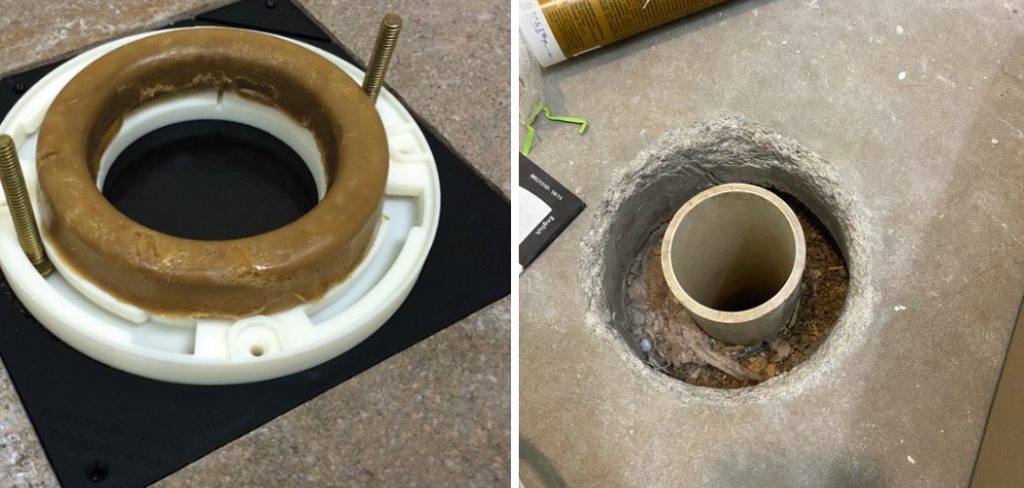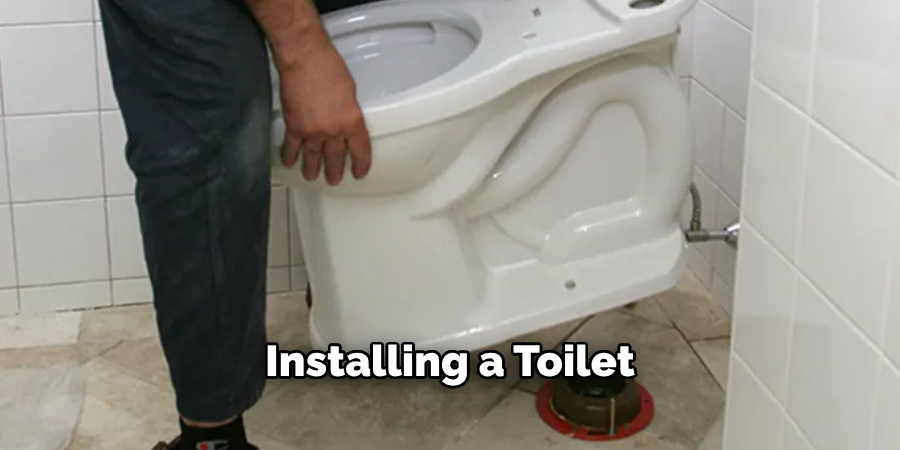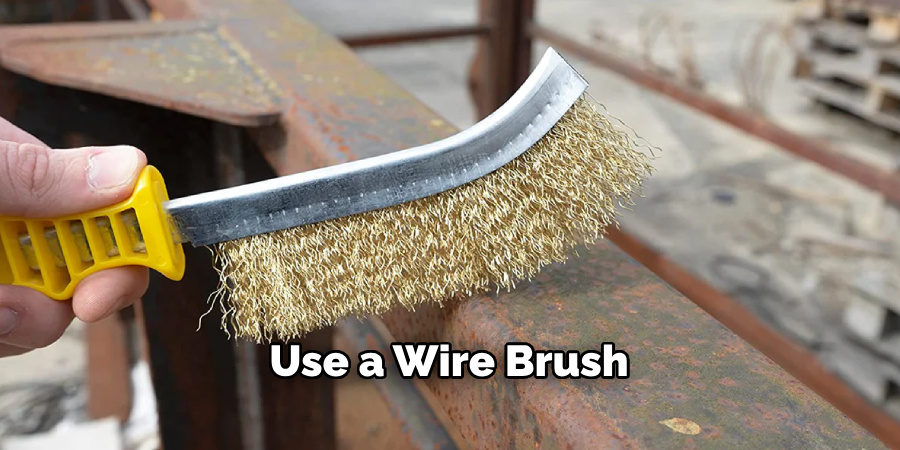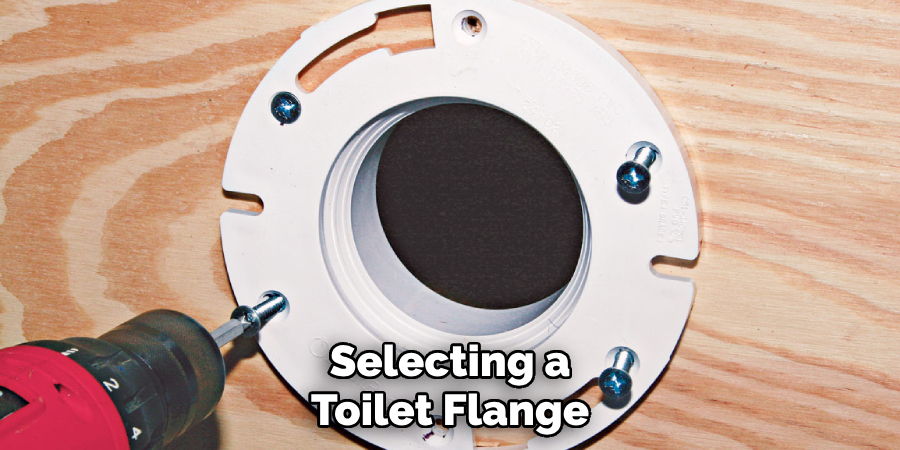A toilet flange, also known as a closet flange, is the base component used to connect the toilet to the sewer drain on the floor. It is essential to ensure your toilet flange is installed properly, as it provides a stable and secure connection for your toilet.

Setting a toilet flange in concrete is a bit more complicated but necessary when installing a toilet on a concrete floor. In this blog post, we will provide a step-by-step guide on how to set a toilet flange in concrete.
Can You Set a Toilet Flange in Concrete?
Setting a toilet flange may seem daunting, but with the right tools and a bit of know-how, it can be a DIY project you can tackle with confidence. A common question is whether or not a toilet flange can be set in concrete. The answer is yes, you can set a toilet flange in concrete, and in fact, it is a common method used by many professionals.
Doing so can provide added stability and security for your toilet, giving you peace of mind knowing your bathroom fixtures are securely in place. However, it is important to follow proper installation procedures to ensure a successful outcome. So if you’re up for the challenge, get ready to conquer those concrete and toilet flange installation hurdles!
Why Should You Set a Toilet Flange in Concrete?
When it comes to installing a toilet, it’s not just a matter of connecting the pipes and calling it a day. One important aspect often overlooked is setting the toilet flange in concrete. While it may seem like an unnecessary step, there are a few reasons why this is an important part of the installation process. Concrete provides a sturdy, stable base for the flange, ensuring that it doesn’t shift or move over time.
This can be especially important in older homes with uneven or damaged flooring. Additionally, concrete can help prevent leaks by creating a tight seal around the flange. So, if you’re installing a new toilet, don’t neglect this crucial step – a concrete-set flange can make all the difference in the longevity and reliability of your toilet installation.

A Step-by-Step Guide on How to Set a Toilet Flange in Concrete
Step 1: Measure the Location
The first step in setting a toilet flange in concrete is to measure the location where the toilet flange will be installed. You should also mark the center point where the flange will be installed. Once the location is marked, use a level and make sure the area is flat and even. If it is not even, you must fill the lower side with additional concrete.
Step 2: Drill Holes
Next, drill holes into the concrete around the marked area using a hammer drill. You will need to drill holes deep enough to accommodate concrete anchors. The size of the holes should be based on the size of your concrete anchors.
Step 3: Clean and Prep the Area
Before setting the toilet flange, clean and prep the area for proper adhesion. Use a wire brush or rag to remove any debris or dust from the concrete surface. This will ensure that the flange has a strong and secure grip on the concrete.

Step 4: Set the Flange
Place the flange into the center hole and align it with the marks you made earlier. Use a level to ensure that the flange is flush with the ground. Once in position, use concrete screws or anchors to secure the flange to the concrete. Make sure to tighten them evenly for a secure fit.
Step 5: Caulk and Add Toilet
Once the flange is securely placed, you can caulk around the edges for added waterproofing. This will prevent any leakage and ensure a clean finish. Finally, install your toilet onto the flange according to the manufacturer’s instructions.
Step 6: Test the Installation
After setting the flange in concrete, it is important to test the installation before using the toilet. Flush several times and check for any leaks or movement of the flange. If there are any issues, go back and make adjustments as needed.
Step 7: Finishing Touches
To complete the process, add a wax ring between the toilet and flange for added protection against leaks. You can also add a toilet base plate for added stability. Once these finishing touches are in place, your toilet should be securely set in concrete and ready to use.
That’s it! You’ve now learned how to set a toilet flange in concrete. Remember to follow these steps carefully for a successful and long-lasting installation. So, next time you need to install a toilet on concrete flooring, you’ll be ready with the proper knowledge and techniques. Stay bold and confident in your DIY skills!
5 Considerations Things When You Need to Set a Toilet Flange in Concrete
1. Measure the Hole
When setting a toilet flange in concrete, it is important to start by measuring the hole in the floor. This will help you determine the size of the flange you need to purchase and ensure it will fit properly. Additionally, it is important to ensure that the hole is large enough for the flange so there is no gap between it and the concrete.
2. Purchase a Flange with a Rubber Gasket
When selecting a toilet flange for your project, it is important to choose one that has a rubber gasket included. The gasket helps to create an airtight seal between the flange and concrete, which helps prevent water from leaking out of your toilet. It is also important to ensure the gasket is compatible with your particular type of toilet.

3. Prepare the Concrete Surface
Before setting your toilet flange in concrete, you should prepare the surface of your concrete floor. This includes cleaning and sanding down any rough edges or bumps on the surface of your concrete floor so that they do not interfere with the installation process. Additionally, you should also check for any cracks or other damage on your concrete floor and repair them before attempting to set your flange in place.
4. Secure Your Flange with Anchors
Once you have prepared the surface of your concrete floor, you can then secure your toilet flange in place using anchors or screws. It is important to make sure that these anchors are securely fastened into place so that they do not come loose over time and cause problems with your toilet installation process. You may also want to use special anchors designed specifically for use in concrete if necessary.
5. Test Your Installation
Once you have secured your toilet flange in place using anchors or screws, it is important to test its installation by filling up a bucket of water and pouring it into a bowl of your newly installed toilet flush system? If everything works properly, then congratulations – you have successfully installed a new toilet flange in concrete!
5 Benefits of Set a Toilet Flange in Concrete
1. Improved Stability
Installing a toilet flange in concrete provides improved stability for the toilet and prevents it from shifting or rocking. This is especially important in high-traffic areas, as the extra support will help ensure the toilet remains firmly in place.
Additionally, installing a toilet flange in concrete eliminates the need for additional shims or other supports, which can be time-consuming and difficult to install.
2. Easier Cleaning
Installing a toilet flange in concrete also makes it easier to clean around the toilet’s base. Without a flange, there is often an area between the floor and the base of the toilet that is difficult to access with a mop or other cleaning tools. When a flange is installed in concrete, this gap is eliminated, making it much easier to keep the bathroom floor clean and free of debris.

3. Reduced Odors
Another benefit of installing a toilet flange in concrete is that it helps to reduce odors from escaping into your home. The seal created by the flange prevents air from leaking out from underneath your toilet, which can cause unpleasant odors to fill your home.
Additionally, when air cannot escape, it helps prevent sewer gases from entering your home through small gaps around your pipes.
4. Increased Durability
Installing a toilet flange in concrete also increases its overall durability and lifespan. The added support provided by the concrete helps to protect against wear and tear caused by everyday use, ensuring that your toilet will remain securely attached for many years to come. Additionally, when properly installed with waterproof cement, this installation can even help protect against water damage caused by leaks or overflows.
5. Cost Savings
Finally, installing a toilet flange in concrete can save you money over time as it eliminates the need for additional materials such as shims or other supports that may be required when installing on top of wood or tile floors.
Additionally, if you are replacing an existing toilet flange damaged due to corrosion or age-related wear and tear, installing one directly into concrete can help extend its lifespan significantly without purchasing any additional materials or supplies.
4 Common Mistakes People Make When Trying to Set a Toilet Flange in Concrete
1. Not Leveling the Toilet Flange
One of the most common mistakes people make when setting a toilet flange in concrete is not leveling it properly. The toilet flange should be level with the surrounding floor, or else it can cause problems with the installation. It’s important to take your time and ensure the flange is level before proceeding with any other steps.
2. Not Securing the Flange With Adhesive
Another mistake people often make when installing a toilet flange in concrete is not securing it with adhesive. The adhesive helps ensure the flange stays in place and doesn’t move around during installation. Make sure to use an appropriate adhesive for your specific type of flange and follow all instructions carefully.

3. Not Using Enough Mortar Around the Flange
When setting a toilet flange in concrete, it’s important to use enough mortar around the flange to ensure a secure fit. If there isn’t enough mortar around the edges of the flange, then there is a chance that it could become loose over time, which could cause leaks or other issues down the road. Make sure to use plenty of mortar and spread it evenly around all sides of the flange for best results.
4. Not Testing for Leaks After Installation
The final common mistake people make when installing a toilet flange in concrete is not testing for leaks after installation. Once you have finished installing your new toilet flange, it’s important to test for any potential leaks by running water into both tanks and checking for any signs of water seeping out from underneath or around the edges of the flange. This will help ensure that you have installed your new toilet correctly and that there are no potential issues.
Conclusion
Properly setting a toilet flange in concrete is crucial to ensuring the stability and durability of your toilet installation. By following our step-by-step guide, you can confidently set your toilet flange in concrete and have a solid foundation for your toilet.
Remember to always measure and level the area, drill and clean the holes properly, install the anchors securely, and let the concrete set before proceeding with your toilet installation. Thanks for reading our post about how to set a toilet flange in concrete and happy DIY-ing!
